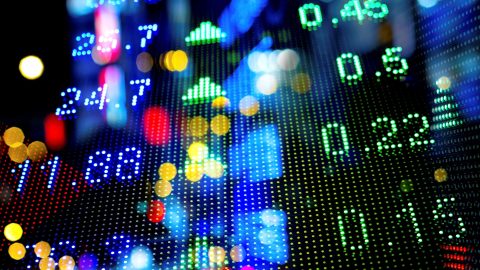Equities have recovered from their beginning-of-year slump, and bonds, especially corporate and emerging markets, have recorded impressive gains. The loosening of the monetary environment in China and the continuation of the loose monetary policy in the USA have reduced the risk aversion of investors. In terms of asset allocation, we generally prefer default risk. Equities remain underweighted.
China: there will be another time
China has loosened its monetary environment. This is mainly due to an increase in credit growth. The budget deficits have expanded as well. Both factors support investment and the property market. The significant increase in property prices is particularly remarkable. For this reason economic growth will improve slightly vis-à-vis the low Q1 value. The fear of a “hard landing” has calmed. – For now, that is to say; it may be rekindled at a later date, seeing that the growth of debt is excessive in relation to economic growth.
No Fed funds rate hike
In the USA the central bank (Fed) has signalled a continuation of its loose monetary policy. The central bank is now less worried about the global economy and the financial market, although both areas remain under close scrutiny. However, economic growth in the USA has fallen. The growth rate of private consumption is subdued, and company investments and net exports are shrinking. Also, industrial production has declined, and banks have tightened lending standards for the corporate sector the third quarter in a row. The medium-term recession risks remain elevated. At least the leading indicators suggest a slightly higher rate of economic growth for the ongoing quarter, and employment growth is comparably high.
US dollar depreciating
The signal sent by the Fed of not raising the Fed funds rate in the foreseeable future has caused the US dollar to depreciate vis-à-vis a currency basket, and especially relative to the currencies of emerging and commodity-producing countries. This allows the central banks in the emerging economies to cut key-lending rates, or alleviates the pressure to raise rates. Here, the focus is on China as well: the depreciation of the US dollar against a currency basket has also facilitated the weakening of the renminbi relative to a currency basket, although the renminbi has actually appreciated slightly to the US dollar. Also, the Chinese foreign currency reserves have stabilised after the earlier, hefty decline. Earlier worries over a chaotic and significant depreciation of the renminbi have dissipated.
The sectors with sharp previous corrections (emerging markets bonds, corporate bonds with low credit quality, commodities, emerging markets currencies, value shares) have recorded significant gains. The risk of interest rate hikes in the USA will be growing particularly if the still subdued growth rate of wages rises. By way of a converse argument, we can therefore expect the US dollar to remain weak and thus support the markets as long as inflation pressure remains low.
Good growth rate in the Eurozone
In the Eurozone the positive effects of the expansive monetary policy have become noticeable. The Eurozone GDP is growing at about 2% above its potential of 1%, the unemployment rate is falling, and credit growth is marginally on the positive side. However, as long as the excessively low rate of inflation doe not show signs of growth towards the inflation target, the ECB will maintain its very expansive monetary stance.
Negative interest rate policy and bond purchases
Given that negative key-lending rates also cause collateral damage, i.e. they are disadvantageous to financial institutions and to the customers of institutional investors, additional monetary loosening will probably rather happen via the extensive bond purchase programme (quantitative easing) and the long-term provision of liquidity to banks at favourable terms (TLTRO). This can help loosening the lending standards of banks (credit easing channel) and of the entire financial environment (portfolio balance effect).
No self-supporting improvement of the environment
Important leading indicators such as the purchasing managers indices do not suggest the self-supporting improvement of the global economy. Foreign trade in goods, industrial production, and company investments remain particularly weak. Also, the valuations across asset classes are generally elevated, company earnings are falling, the availability of additional economic and monetary signals has decreased, and the volume of debt in the private sector of emerging economies has increased.
Environment remains fragile
Two conclusions can be drawn:
- The susceptibility of the financial market to bad news remains elevated
- Additional monetary and economic stimulus measures are the driving factors for the positive development on the markets. The effect of such measures does, however, decline over time. In the short run, the wait-and-see stance of the Fed, which facilitates a depreciating US dollar, and the increased credit growth in China support the prices of risky assets.
Default risk preferred
In terms of asset allocation, we generally prefer default risk, i.e. primarily corporate bonds with low credit quality (high-yield), CEE government bonds, and emerging markets government bonds (hedged in USD). Equities remain underweighted.
Legal disclaimer
This document is an advertisement. Unless indicated otherwise, source: Erste Asset Management GmbH. The language of communication of the sales offices is German and the languages of communication of the Management Company also include English.
The prospectus for UCITS funds (including any amendments) is prepared and published in accordance with the provisions of the InvFG 2011 as amended. Information for Investors pursuant to § 21 AIFMG is prepared for the alternative investment funds (AIF) administered by Erste Asset Management GmbH pursuant to the provisions of the AIFMG in conjunction with the InvFG 2011.
The currently valid versions of the prospectus, the Information for Investors pursuant to § 21 AIFMG, and the key information document can be found on the website www.erste-am.com under “Mandatory publications” and can be obtained free of charge by interested investors at the offices of the Management Company and at the offices of the depositary bank. The exact date of the most recent publication of the prospectus, the languages in which the key information document is available, and any other locations where the documents can be obtained are indicated on the website www.erste-am.com. A summary of the investor rights is available in German and English on the website www.erste-am.com/investor-rights and can also be obtained from the Management Company.
The Management Company can decide to suspend the provisions it has taken for the sale of unit certificates in other countries in accordance with the regulatory requirements.
Note: You are about to purchase a product that may be difficult to understand. We recommend that you read the indicated fund documents before making an investment decision. In addition to the locations listed above, you can obtain these documents free of charge at the offices of the referring Sparkassen bank and the offices of Erste Bank der oesterreichischen Sparkassen AG. You can also access these documents electronically at www.erste-am.com.
N.B.: The performance scenarios listed in the key information document are based on a calculation method that is specified in an EU regulation. The future market development cannot be accurately predicted. The depicted performance scenarios merely present potential earnings, but are based on the earnings in the recent past. The actual earnings may be lower than indicated. Our analyses and conclusions are general in nature and do not take into account the individual characteristics of our investors in terms of earnings, taxation, experience and knowledge, investment objective, financial position, capacity for loss, and risk tolerance.
Please note: Past performance is not a reliable indicator of the future performance of a fund. Investments in securities entail risks in addition to the opportunities presented here. The value of units and their earnings can rise and fall. Changes in exchange rates can also have a positive or negative effect on the value of an investment. For this reason, you may receive less than your originally invested amount when you redeem your units. Persons who are interested in purchasing units in investment funds are advised to read the current fund prospectus(es) and the Information for Investors pursuant to § 21 AIFMG, especially the risk notices they contain, before making an investment decision. If the fund currency is different than the investor’s home currency, changes in the relevant exchange rate can positively or negatively influence the value of the investment and the amount of the costs associated with the fund in the home currency.
We are not permitted to directly or indirectly offer, sell, transfer, or deliver this financial product to natural or legal persons whose place of residence or domicile is located in a country where this is legally prohibited. In this case, we may not provide any product information, either.
Please consult the corresponding information in the fund prospectus and the Information for Investors pursuant to § 21 AIFMG for restrictions on the sale of the fund to American or Russian citizens.
It is expressly noted that this communication does not provide any investment recommendations, but only expresses our current market assessment. Thus, this communication is not a substitute for investment advice, does not take into account the legal regulations aimed at promoting the independence of financial analyses, and is not subject to a prohibition on trading following the distribution of financial analyses.
This document does not represent a sales activity of the Management Company and therefore may not be construed as an offer for the purchase or sale of financial or investment instruments.
Erste Asset Management GmbH is affiliated with the referring Sparkassen banks and Erste Bank.
Please also read the “Information about us and our securities services” published by your bank.
Subject to misprints and errors.



